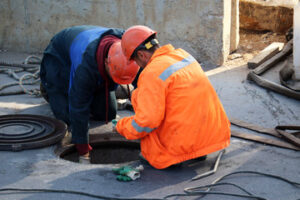Plumbing problems can be dangerous and lead to costly damage if not addressed quickly. From wet rings on your ceiling to backed-up sewer lines, these issues should be taken seriously and dealt with immediately.

A career in plumbing offers stability, flexibility, and growth potential. It can also be rewarding and satisfying, especially with multiple routes to licensure and certification. Contact Plumber Topeka KS to learn more.
Even with regular drain cleaning and sewer line maintenance, cracked or broken sewer pipes can still develop. Several factors can contribute to this, including age, corrosion and ground movement. Understanding these issues can help you identify if your sewer line is cracked and what the best course of action is.
When a crack or hole in the sewer line isn’t repaired quickly enough, it can lead to a backup in your home. This can cause a number of problems, including flooding, septic system overflow and sewage back-ups. The sewage can also contaminate water supplies and even cause health hazards.
The first sign of a sewer leak is usually a strong odor that doesn’t go away with drain cleaners. This is caused by sewage seeping through the crack and into your home’s plumbing. If you notice this odor, call your plumber right away to schedule a drain inspection.
Another common sign is a clogged or slow-running drain. This is typically because of an obstruction in the main sewer line and can affect all drains throughout your house. A plumber can check the entire line to determine what’s causing it and fix it.
A cracked sewer line can also cause a backup of sewage into your yard, which can have several negative effects on the health of your property and your family. For example, the sewage can contaminate the soil around your home and even create a sinkhole. In addition, sewage can also seep into the groundwater supply and cause contamination.
Besides the sanitary and safety issues, a cracked sewer line can also attract unwanted pests such as rats and roaches. These pests can get into your home through the crack or gap in the pipe and cause additional damage.
Minor cracks in a sewer line don’t have as severe of an impact on the function of your home or garden. If the cracks are small, a plumber may be able to repair them with modern technology and in a non-intrusive manner. However, if the problem is extensive, you may need to replace your entire sewer line.
Root intrusion
When it comes to your sewer line, root intrusion is a serious problem that can cause toxic sewage backups and expensive repairs. Roots are naturally attracted to water, and they will grow into any cracks or holes in your pipes, especially if there is moisture. It’s important to cut down any old or diseased trees in your yard, and to plant new ones far away from your plumbing lines. Regular sewer camera inspections can also help prevent problems with your sewer lines.
Most homes will deal with clogged drains from time to time, but if you’re experiencing frequent clogs or hearing gurgling sounds coming from your toilet or sink drain, it could be a sign of damage caused by root intrusion. If left untreated, root intrusion can lead to major damage to your sewer lines, including cracking and collapse.
One of the most common signs of root intrusion is foul odors around your home or in your yard. Sewage backups are a dangerous health hazard for you and your family, and they’re also hard to ignore. If you’re noticing these smells, it’s important to call a plumber right away.
Another symptom of root intrusion is a buildup of debris in your sewer line. Roots will tamper with the transportation of sewage, which will eventually create a layer of leaves and bark that will block the pipe. This is known as the “root rake effect.”
Sewer line repair is a complicated process that requires the expertise of a professional plumber. It’s important to hire a plumber who has experience working on both residential and commercial properties. They will be able to assess your specific needs and provide the best solution for your plumbing issues.
If you’re dealing with a damaged or clogged sewer line, the team at Harts Services can help. We offer fast and affordable sewer repairs, as well as plumbing, electrical, and HVAC services. Contact us today to schedule an appointment. We look forward to helping you with all of your home maintenance needs!
Back pitch
It is common for plumbers to diagnose back pitch in a sewer line. This is often due to dirt that has settled around a section of the pipe causing it to sink creating negative slope. This causes waste and water that should go downhill to stop in the sunken area. However, the problem may be more serious such as a separate line from the city sewer separated under the sidewalk or even in the city sewer itself.
Sewer line replacement
The sewer line is a vital component of the plumbing system, carrying waste from the home to the mainline. However, like any other part of the plumbing system, it can suffer damage from time and use. If you notice signs of a failing or broken sewer line, such as slow drains or smelly sewage, it’s important to get the problem addressed right away. A plumber can inspect the line using a special camera and determine the severity of the issue. They may recommend repair or replacement based on the inspection results.
Traditionally, replacing the sewer line is a very invasive process that involves digging a trench across the property to locate and remove the existing line. This can damage sidewalks, driveways, patios, and lawns. However, with new technology such as trenchless sewer line replacement, there’s no need to dig a single trench to find and replace the old pipe.
Trenchless options include epoxy lining, pipe bursting, and micro-tunneling. With the first option, a plumber can insert an epoxy resin into the interior of the sewer drain with the help of a video camera. Then, they can inflate a bladder, which will force the epoxy into the cracks and gaps of the old pipe. This method is quick and works with PVC, clay, and cast iron pipes.
Another way to fix a failing sewer line is to install a clean-out point. A clean-out point is a section of the sewer line that’s accessible by unscrewing a cap. This can be a great way to clear out a clogged sewer line and save you from having to pay for a full sewer line replacement.
Sewer lines need to be replaced when they reach the end of their lifespan. This is usually due to age, but can also be caused by tree root intrusion or improper installation. A new sewer line can increase your property value, and you’ll also benefit from having a more dependable and functional plumbing system.
If you need to replace your sewer line, be sure to work with a reputable company that uses safe and efficient methods. Ask your plumber to give you an estimated timeline so that you can plan accordingly and make accommodations during the work. This will keep your daily routines from being disrupted too much, and it’ll give you peace of mind that the work is being done correctly.
